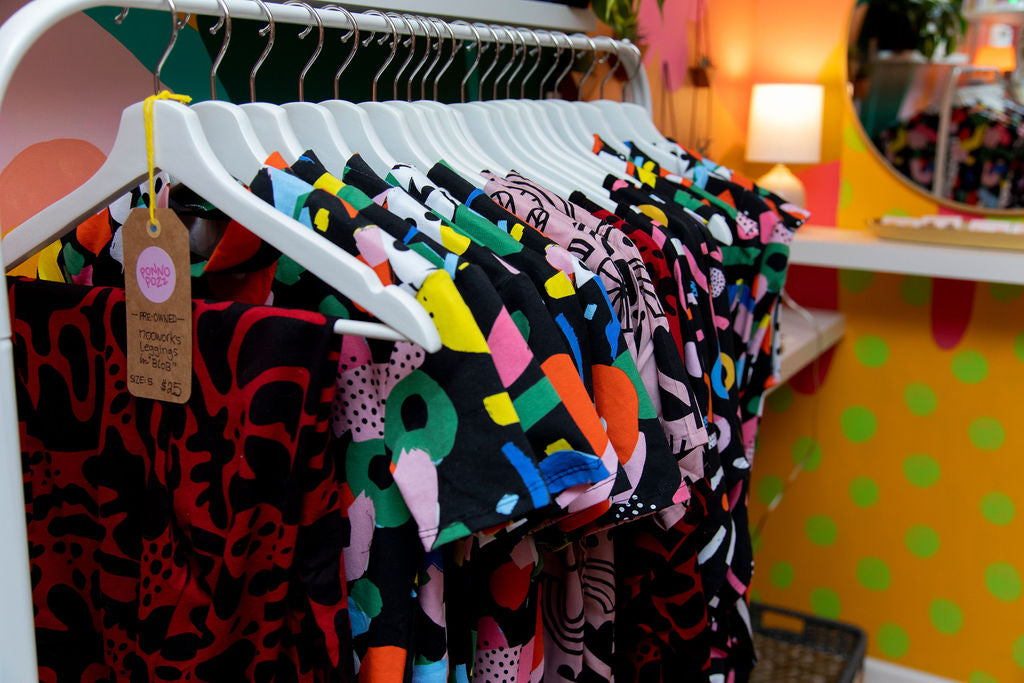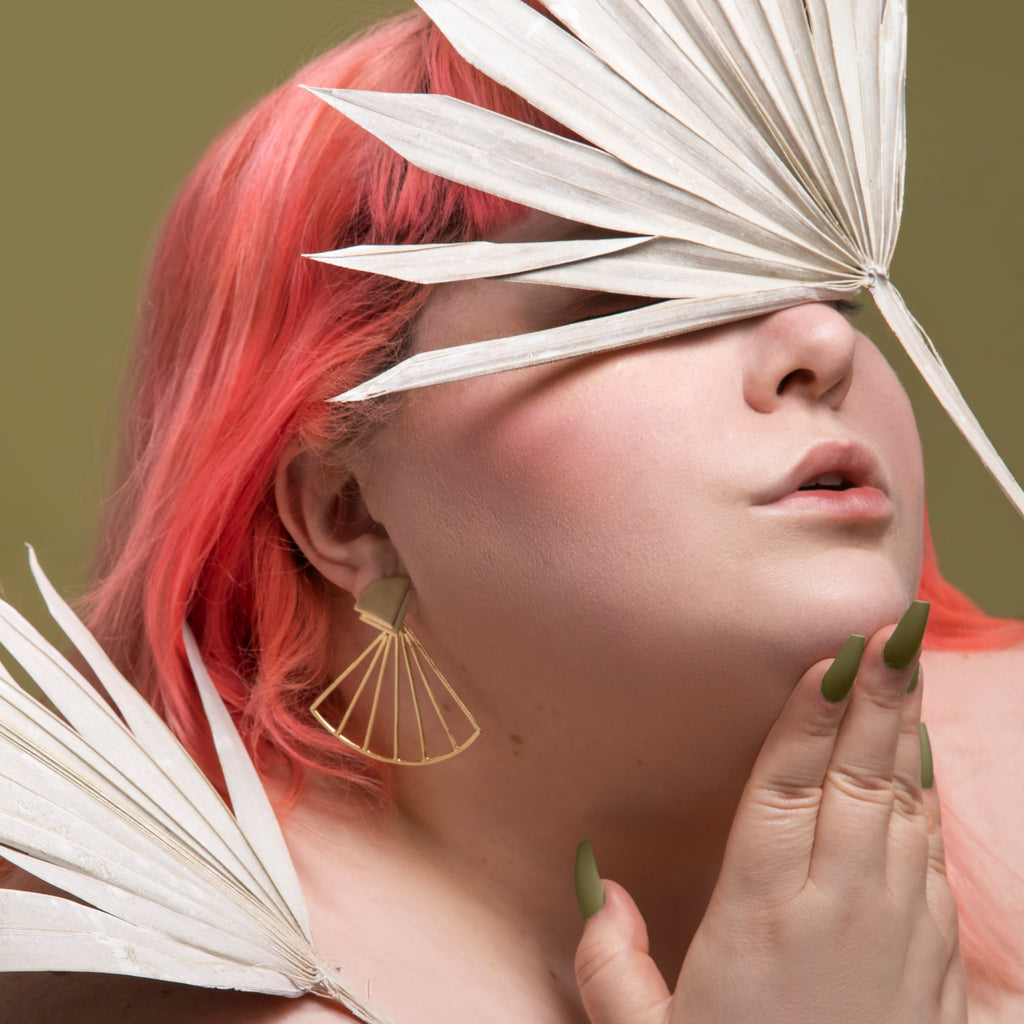Why Size Inclusivity Matters

This post features contributions by guest collaborator Amy Lynn Straub. We discuss size exclusivity in fashion and fat-bias in this post. All photos in this post were taken by Amy Lynn and cannot be used without permission.
As I sit down to write about size inclusivity, I feel nervous. This is by design. Society has ingrained in us that being thin is "beautiful" and being anything but that is "less than." It sends harmful messages to all of us, and impacts people who don't fit into the small, medium, large narrative the most. This same narrative tells us that "fat" is a bad word and talking about (much less carrying) larger sizes in a shop is a waste of time and money. This is why I'm nervous. I grew up learning that being fat was bad and not to talk about it. Writing this post feels uncomfortable because I've made all of the above mistakes.
As a straight sized person, I've never had my fashion choices limited. I never stopped to think about what it must be like to visit a store and leave empty handed because my size was unavailable. I never realized how exclusive the fashion industry really is – even outside of the people the industry employs as models. Most companies don't bother making clothing in sizes past XL. But why not? Did you know the actual average clothing size is 2XL? I didn't!
When I opened my first Ponnopozz shop in the fall of 2019, I remember shopping for clothing ahead of the shop's opening. I chose sizes S, M, L and XL in several pieces by one of my favorite companies, Nooworks. I was nervous about costs at the time, and adding 2XL and 3XL didn't seem worth it. It was more product, more upfront costs, and no guarantee that the larger sizes would sell. Or so I thought...
After being open a few months, I realized how narrow minded I was and I quickly realized I was part of the problem. Buying ANYTHING for a shop is a risk – you never really know what your customers are looking for. Why was it OK for me to roll the dice on S, M, L, XL but not 2X, 3X, 4X and beyond?

By summer of 2020, I decided that if I was going to carry clothing, I had to buy at least one of every size. So, I started to do that. At the time, most Nooworks pieces only went to 3XL (they've since expanded their line up to 5XL and often sell out of the larger sizes first). I made sure to order every size, every time. What I found surprised me – I would sell ALL the larger sizes and was usually left with an XS or two on the racks. This is completely opposite of what I was taught / expected. I didn't realize how my own narrow thinking had barred a large part of the population from shopping with me.
Now, the PonnoPlace is stocked with apparel in every size available. At the moment, we carry Nooworks (up to 5XL) and my own leggings line (up to 6XL). After more than a year of doing this, I can say with confidence that all sizes sell. It saddens me when shoppers are surprised by the range of sizes we carry. It drives home how isolating and dehumanizing shopping can be for the plus community. Just seeing a pair of 6XL leggings on the rack at the shop is shocking to many, but it shouldn't be. It should be normal.
One time, I was in my studio, working. My studio shares a wall with the shop's Peach Room, which includes our dressing room. Occasionally I hear shoppers chatting while trying things on but I typically am so immersed in my work that I don't pay much attention. Except this one time. I heard someone make a phone call while in the fitting room, saying they had randomly happened upon my shop. They proceeded to say how surpised they were to find their size on our racks. And how this never happens, how they can never walk into a shop and try anything on. I seriously wanted to cry. I didn't mean to eavesdrop, but I also think I was meant to hear that snippet of conversation. To drive home how important inclusivity is and why it's important that I continue to stock all sizes. It's because:
Ponnopozz strives to be a safe, welcoming place. Making the conscious decision to carry sizes XS-6XL was (sadly) a big step, as not many businesses do this.
I've learned a lot about this issue (including the term "straight sized') from my friend and fellow artist, Amy Lynn Straub. She told me a lot about her struggles with the fatphobic fashion industry and it really opened my eyes. I decided to interview her for the second half of this post. Her answers are honest and so telling of an issue that needs to change. We all can do better (and I'll provide some action items that you can take at the end of this post).

Can you tell my readers a little about yourself?
Of course! I’m Amy Lynn, a pink-haired fat artist, creative, photographer, videographer, and designer with ADHD which keeps me always finding new mediums and forms of expression. I love joy and color, which of course means I’m a big fan of Ponnopozz and so grateful your shop is in my neighborhood.
Why is size inclusivity an issue you're invested in?
Well I think the most personal reason is because my life has been drastically impacted nearly everyday since childhood by size exclusion in the fashion industry. I can count on one hand the amount of times I’ve been able to shop for clothes I like that feel like me in person. It’s only in the past 5 years that I’ve even been able to find clothes that I feel good wearing because they match my aesthetic. But beyond my personal experience - size exclusion doesn’t even make sense. Morally or as a business strategy. Nearly 70% of the population is in the range the fashion industry considers “plus size” but only 8% of all clothing is made available in this size range.
Most brands size charts cut off before they even reach a 2XL which is the average size person. It’s really mind-boggling.
Why is size inclusivity so important?
I get this question a lot specifically related to fashion. I think sometimes people can see trendy/fashionable clothing as something frivolous, but I think that notion is bullshit. Putting clothes on your body is something you do pretty much every day. Being able to put on clothes you like, that feel like you, and that you feel good in - is an empowering and life propelling experience. It effects everything. The jobs you feel confident to apply for, the party invitations you say yes to, how comfortable you feel on a date or making new friends, and even the motivation you have to leave the house. The majority of people don’t have access to that freedom of choice + expression when they get dressed that straight size folks have. Plus the fashion industry pretending that the majority of bodies are sizes S-L, and only feeding us images of these bodies is wreaking havoc on all of us and our body image.
What is it really like to be a plus-sized consumer?
Frustrating and exhausting. I’m constantly falling in love with trends and items of clothing that never come in my size. I get linked to a brand by a friend that claims they are size inclusive - only to check out their size chart and see their sizes cut off before the average size person.
I decide I’d really like to have something like a pink coat, only to literally not be able to find one pink coat in my size, while straight size folks can pick from hundreds of pink coats.
It means never being able to buy shirts or sweatshirts from small makers because I know the blanks they use don’t come in plus sizes. It means if I really wanna specific special clothing item, I have to learn how to make it myself - and learn how to make a pattern for making it myself - because sewing patterns sizes are just as gate kept as the fashion industry is. It also means almost never being able to find clothes in person, I always have to shop online. I don’t get to just go shop at the mall, or run out and grab an outfit for a last second weekend event invite. If I fly somewhere and they lose my luggage, I won’t be able to find clothes much less a swimsuit to buy locally.
What are some of your favorite size inclusive brands?
I’ve really been obsessed with Wray lately. I’m pretty much always rocking their checker pants. Lucy and Yak recently expanded their sizing. Not every garment is in the full size range (sighs) but their dungarees + jackets are some of my favorite pieces. ARQ is my favorite for comfy bras and undies. And for everything else I’m limited to mostly Target, Old Navy, and ASOS.

What language should brands use or avoid when it comes to inclusive sizing?
Verbiage can be tricky to navigate, because it’s important to advertise that you carry a larger range of sizes than people are used to, especially because larger customers may not even look at your sizing or walk into your store because they are so used to being excluded. I think the best way to communicate that you have a large range of sizes is to just list clearly what you carry. For example: S-6XL. And to make sure you feature bodies from different points in that size range on your website + social media feed. If you have an in person retail store: I’d put a visible sign on your racks that list the size range available: like with the designers name + the available sizes. I’d even stick a decal on your window that says what size clothes you carry, I’d bet you’d be surprised how many more people walk into your store who would have just walked by before.
I’d avoid using the terms “fits all” “inclusive” or that your clothes are made for “every body” or “every one” in any branding. There are always going to be people who are larger or smaller than your range or who have disabilities that make your clothing inaccessible to them. This language is dehumanizing.
What are some brands you avoid and why?
I won’t shop at any brand who markets themselves as “inclusive” or “for everyone” or “body positive” when they clearly aren’t. I think brands that market to fat folks + feign inclusivity without offering any real access to larger size bodies are the worst. I think the best thing straight size folks can do to be an ally is to take stock of what sizes are available at the stores they shop in, and ask for those sizes to be expanded. Use your privilege!
Why is it important for small businesses like Ponnopozz to invest in inclusive sizing?
I think the best part about being a small business is you get to decide what your values are, what you stand for, and what kind of space + impact you make for people in your community. I can’t express how freeing it is to be able to walk into a store with a straight size friend, fall in love with an item of clothing I see, and be able to buy it, instead of just watching my straight size friend shop around. Customers remember how you made them feel, and there’s nothing that feels better than access when you’re used to exclusion.

OK I've learned a lot from you just from this written interview. I'm definitely going to add sizing signage to our clothing racks and put a decal in the window. Before I conclude, tell us about the clothing line you're creating! That's a big deal!
For sure! I’m in the process of launching a clothing brand called JOYTOAST. It’s a wild + colorful genderless brand that will be available in S-7XL (with made to order beyond 7XL) that’s totally my vibe. I’ve been working on our first collection for the past six months, and we’re in the sampling stage now + will be launching a Kickstarter for preorders soon. Being able to wholesale to shops like Ponnopozz is an important part of of JOYTOAST, because we believe in-person clothing access matters. If there’s any small businesses reading this that would love to stock a colorful brand that comes in a range of sizes, they should sign up for our wholesale waitlist!
Thank you so much, Amy Lynn! Just so you know, Ponnopozz will absolutely be stocking JOYTOAST once it launches!
I learned a lot from this interview and have complied a short list of things you can do to help make shops and fashion more inclusive:
- Speak up when your favorite clothing brands don't carry sizes past XL. Email them about how this concerns you and remind them that they are excluding a large number of shoppers.
- If you own a small business that carries clothing, expand your size range to include larger sizes.
- Vote with your dollar! Shop with brands that have a wide range of sizes.
- Work on your own internal thoughts and biases about fashion and size inclusivity. This does not have to be done publicly. Unpack what you've always been told and put yourself in someone else's shoes. The first step is awareness.
This is by no means an extensive list and will be added to over time. I know I can do better with many of the points mentioned above.
Resources
Here are some additional resources for unpacking fatphobia and for fashion inclusivity activism, shared by Amy Lynn:
- @bodyimage_therapist – an incredible resource for reflection on body image work + focuses on art therapy.
- @saucyewest – their #fightforinclusivity campaign is fighting for more size access in the fashion industry + provides a great list of brands that are carrying a wide range of sizes.
- @yrfatfriend – whose writing is incredible and calls us in to be better ally's to our fat friends, also her podcast @maintenecephase is a life-changer that will help you to revisit and unpack what you think you know about the wellness industry + diet culture.
Thanks for taking the time to read this post. Please share it with others! And before you go, check out Amy Lynn's Instagram and follow her new brand, JOYTOAST!
- Follow Amy Lynn on Instagram @amymeetsjoy
- Follow JOYTOAST on Instagram @shopjoytoast or visit www.shopjoytoast to learn more. Be the first to know when JOYTOAST launches by joining their mailing list.
- Are you a small business interested in carrying JOYTOAST? Sign up for the wholesale waitlist.
